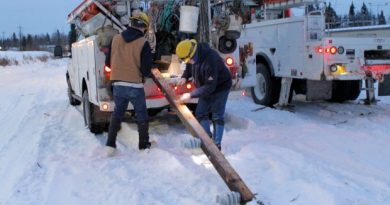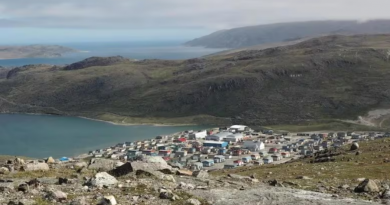After early containment success, there’s now rapid COVID-19 spread in rural Alaska, including the Arctic

At the beginning of the coronavirus pandemic, many rural communities acted quickly to impose strict quarantine measures in order to keep the virus out of their tight-knit towns. That was largely successful in stalling the spread of COVID-19.
But in the past several weeks that’s started to change. Clusters of cases have flared up in dozens of villages across the state.
Gambell, Quinhagak, Stebbins, Buckland and Utqiagvik have reported recent cluster outbreaks. Some of those villages had case counts that grew quickly to dozens of people. Rural cases make up just over one in 10 reported cases statewide. Still the sudden rapid growth is a worrying sign.
“It’s a building crisis, but it’s not as loud as when you see 100 cases a day in Anchorage or 60 cases a day in Fairbanks,” said Christina McDonogh, a law student originally from Perryville who has been tracking rural COVID-19 cases on a Facebook group.
Northern and Northwest Alaska have highest case rates
Northern and Northwest Alaska, which is comprised entirely of off-the-road villages, now have the highest case rates — the number of average daily positive cases capita over the last week — in the state. Crowded housing and reliance on air travel makes containing the spread especially difficult.

Kotzebue resident Maija Lukin was diagnosed with COVID-19 about two weeks ago.
She got a rapid test in town and returned home. About 45 minutes later, she got a call from the clinic informing her she was positive. Without saying a word, her husband put on a mask and held one out for her to do the same She put it on while still on the phone. They had recently lost a friend to the virus, and so fear of it was still raw.
“I just started crying and (my husband) was like ‘you’re not positive, you’re not positive’ and I was staring at him with tears running down my face,” she said.
But Lukin and her family were fortunate: they had a large house with their kids’ empty bedrooms, which allowed them to isolate within the same home. She hung up a blanket as a divider wall, so she could use the lower part of the house, which had its own kitchen and bathroom, as well as a separate entrance.
“I was packing things like packing clothes for myself to go into the other side of the house,” she said.
Her husband and 3-year-old granddaughter, who she takes care of, would stay on one side of the house in the hopes that they wouldn’t catch the virus, while she isolated in the other. But separating a three-year-old from her grandmother wasn’t easy.
“Our granddaughter freaked out. And she was like, ‘Where’s my ana, don’t leave me!’” said Lukin.
Social distancing challenges in rural communities
Multigenerational households and extended families living nearby are much more common in rural Alaska than in the urban parts of the state, making social distancing especially hard. Some communities have imposed harsh lockdowns and families are having to make tough decisions to stop seeing elders or kids. But that’s not always enough to keep the disease out, and the virus has found a way to sneak into dozens of rural communities, where it can spread quickly.
“When you’re living in a rural place, you’re used to stopping by people’s houses. That’s how you pass the time, you stop by your grandma’s house, you stop by your uncle’s house, usually don’t even knock on the door. But with that being unsafe now, it’s very, very difficult to feel feel like yourself, and to feel connected to who you are,” said McDonogh.
McDonogh said that after many medical appointments were delayed early on in the pandemic, she’s heard of a new vector of transmission: medical transports.
“For people to receive routine medical care, they have to fly to Anchorage, or to Fairbanks. And these are the two huge hot spots in the state,” she said.
Of course, she says, medical care shouldn’t be delayed. But she’s hoping that residents and officials keep paying attention to making sure people have places to quarantine when they return to their villages.
Case numbers raising hospital capacity concerns

State officials say they’ve been working with tribes to plan for large outbreaks. They have conducted staged exercises for how to respond if there is one, according to Tim Struna, Chief of Public Health Nursing for the state of Alaska.
“It is a concern for everybody, and everybody is passionate about making sure that as soon as a case is identified, that there’s this, this team that is going to surround it and do everything they can to keep it as contained and as small as possible,” he said at a Thursday press conference.
Despite their best efforts, many worry that if cases around the state continue to rise, it could mean trouble for rural communities who rely on cities for their healthcare.
“If Anchorage is full, where are they going to send people? They can send people to Seattle, where they have their own number of cases? It’s a really big problem,” she said.
Next two weeks critical
So far, Anchorage’s ICU capacity has been within a normal range for this time of year, according to Jared Kosin, president of the Alaska State Hospital and Nursing Home Association. But he warned that could change soon following a spike in cases that began over two weeks ago. Normally, it takes about two weeks for a surge in cases to manifest as more filled beds.
“It’s really important to remember that hospital capacity, the number of beds you have available is a lagging indicator. So if you’re trying to use capacity as a measure, for the pandemic, you’re getting the wrong indicator,” he said at a Thusday press conference.
That’s why officials are renewing calls on city-dwellers to mask up and take other precautions to make sure that rural residents have access to the hospital beds they’ll need.
As for Maija Lukin’s granddaughter – Lukin decided that living at different ends of the house was worse than the increased risk of her catching COVID. Lukin is wearing a mask at home and letting her granddaughter sleep with her, but in a different bed on the other side of the room.
Related stories from around the North:
Canada: Inuit region of Arctic Quebec to start double testing travellers for COVID-19, Eye on the Arctic
Finland: Finnair to end flights to five regional airports, including to Kemi, Lapland, Yle News
Denmark: Faroe Islands updates COVID-19 guidelines for travellers, Eye on the Arctic
Greenland: Greenland approves revised COVID-19 strategy, Eye on the Arctic
Iceland: Iceland to continue double screening for COVID-19 until December 1, Eye on the Arctic
Norway: Norwegians with Swedish property threaten legal action over travel restrictions, Radio Sweden
Sweden: Finland, UK to remove travel restrictions on Sweden, Radio Sweden
United States: To stop coronavirus, Arctic communities took matters into their own hands. Can it last?, Blog by Mia Bennett



